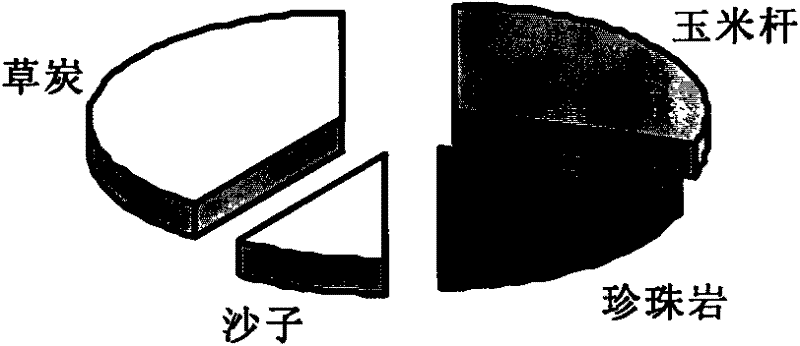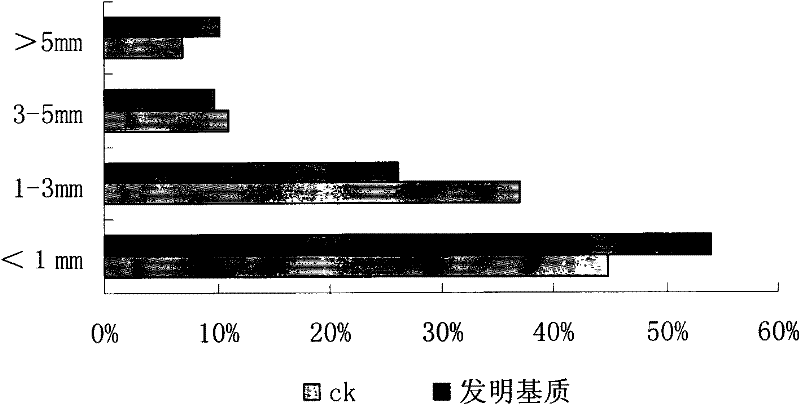Cultivating substrate
A cultivation medium and impurity technology, applied in the field of resource utilization of agricultural organic matter, can solve problems such as not being effectively utilized, and achieve the effects of reducing the use of peat, reducing production costs, and excellent physical and chemical properties
- Summary
- Abstract
- Description
- Claims
- Application Information
AI Technical Summary
Problems solved by technology
Method used
Image
Examples
Embodiment 1
[0025] The preparation of lily cultivation medium of the present invention, concrete steps are as follows:
[0026] Taking the preparation of a lily cultivation medium with a volume of 10L as an example, the single components of cornstalk, perlite, sand and peat were mixed in sequence according to the volume ratio of 3:2:1:4. At the same time, the usual cultivation substrate (7 peat: 3 perlite) was selected as the control (CK).
[0027] (1) Measure 3L corn stalks; (crushed and cut to a particle size of 2cm)
[0028] (2) Measure 2L of perlite (large particle size, rinse the dust with running water, and place it in a ventilated place to dry);
[0029] (3) Measure 1L of sand (medium particle size);
[0030] (4) Measure 4L peat;
[0031] (5) The above-mentioned individual components are fully mixed and set aside.
[0032] It needs to be pointed out that the total volume of each single component will decrease during the mixing process; in addition, the substrate must be watered...
Embodiment 2
[0042] The preparation of lily cultivation medium of the present invention, concrete steps are as follows:
[0043] Taking the preparation of a lily cultivation medium with a volume of 10.5L as an example, each single component of corn stalk, perlite, sand and peat is mixed in sequence according to the volume ratio of 3.5:2:1.5:3.5. At the same time, the usual cultivation substrate (7 peat: 3 perlite) was selected as the control (CK).
[0044] The particle size composition of the sand used is: 5mm accounts for 9%.
[0045] The particle size composition of the perlite used is: <1mm accounts for 7%; 1-3mm accounts for 64%; 3-5mm accounts for 29%.
[0046] The particle size composition of peat used is as follows: 5mm accounts for 24%.
[0047] (1) Measure 3.5L corn stalks; (crushed and cut to a particle size of 1.0cm);
[0048] (2) Measure 2L of perlite (wash the floating dust with running water and place it in a ventilated place to dry);
[0049] (3) Measure 1.5L sand;
[0...
Embodiment 3
[0055] The preparation of lily cultivation medium of the present invention, concrete steps are as follows:
[0056] Take the preparation of a lily cultivation medium with a volume of 9L as an example, each single component is corn stalk, perlite, sand and peat.
[0057] (1) Measure 2.5L corn stalks; (crushed and cut to a particle size of 2cm);
[0058] (2) Measure 1.5L perlite (large particle size, rinse the dust with running water, place it in a ventilated place to dry);
[0059] (3) Measure 1.5L sand (medium particle size);
[0060] (4) Measure 3.5L peat;
[0061] (5) The above-mentioned individual components are fully mixed and set aside.
[0062] It needs to be pointed out that the total volume of each single component will decrease during the mixing process; in addition, the substrate must be watered and settled before use, and watering can also reduce the temperature of the substrate. This requires consideration of a 30% volume increase when formulating the matrix. ...
PUM
 Login to View More
Login to View More Abstract
Description
Claims
Application Information
 Login to View More
Login to View More - R&D
- Intellectual Property
- Life Sciences
- Materials
- Tech Scout
- Unparalleled Data Quality
- Higher Quality Content
- 60% Fewer Hallucinations
Browse by: Latest US Patents, China's latest patents, Technical Efficacy Thesaurus, Application Domain, Technology Topic, Popular Technical Reports.
© 2025 PatSnap. All rights reserved.Legal|Privacy policy|Modern Slavery Act Transparency Statement|Sitemap|About US| Contact US: help@patsnap.com



